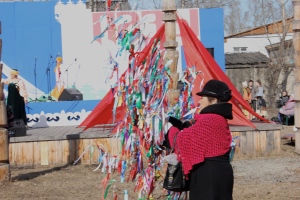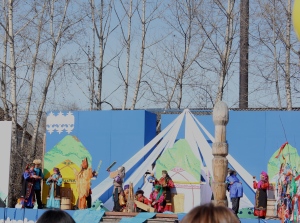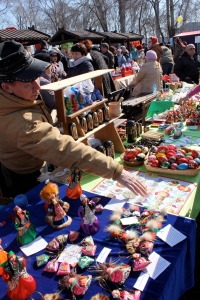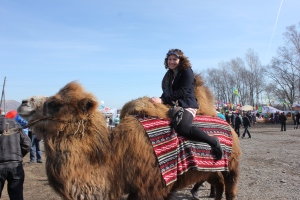New year in Khakassia—Chyl-Pazy
If you live in southern Siberia, you might have the opportunity to celebrate New Years at least three times in a year. Since Southern Siberian people measure time according to the calendar system developed by their Turk-Mongol ancestors, New Years is celebrated after December, Buryatiya celebrates Sharanaam—the “white” month—one month after the first new moon following the winter solstice. At the beginning of February, Tuvan people celebrate Shagaa by cleansing their souls with the help of a shaman and casting offerings of food and juniper into open fires.
New Year in Khakassia, known by its Khakas name Chyl-Pazy, happens at the end of March, on the day of the spring equinox. Chyl Pazy, which literally means “the beginning of the year,” celebrates the rebirth of nature. In ancient Khakas culture, people underwent a cleansing period before celebrating Chyl-Pazy. Everybody had to clean their yurts inside and out, clean the remaining snow, and throw out old clothes and shoes. The felt coverlet attached over the chimney had to be taken out and aired until the smell of smoke disappeared. After cleaning everything, people would have to visit their neighbor’s yurt, at least for a while to wish them a happy new year by saying: “The new year has come, the snake has shed its skin.”
Due to sovietization, Chyl Pazy traditions have changed throughout time. People no longer live in yurts and wait for a bird’s first flight to begin Chil Pazy, nor do they wait for the first roll of thunder to end the celebrations. Chyl-Pazy was established as an official holiday after Khakassia gained its autonomy in the early nineties and is now celebrated in the form of a festival. Khakas rural communities often celebrate Chyl Pazy independently and have their own customs.
This year, Chyl Pazy was celebrated in March 22nd at the hippodrome in Abakan. The holiday usually begins with an opening ritual, performed over an open fire. A shaman invokes the spirits of ancestors and “feeds” offerings of meat, fat, milk, and bread through the fire. Another part of the ritual consists in planting a small birch tree and tying different-colored ribbons—known as chalamas– from its branches. Each chalama’s color has a different meaning: white represents cleanness and pure thought; blue represents the sky and eternity; red¬—the sun and warmth. Black ribbons, which represents problems and other infirmities such as diseases, are symbolically thrown into a separate fire during the opening ritual.
It is customary for people to tie ribbons from a newly planted birch tree. People choose the color that represent their wish for the new year.
After this ceremony, I was left to roam around the festival. There were performances by famous folk artists, throat singing, and theatrical adaptations of traditional Khakas folk tales. Little faux villages named after different towns in Khakassia were set up; each of them had its own yurt and sold local handicrafts. Unfortunately, the yurts were too crowded and I was not able to go inside.
Aside from being one of the most important Khakas traditions, the celebration of Chyl-Pazy is also an opportunity for independent artists. Abakan’s writers’ union was selling books by Khakas writers and recordings of ancient Khakas epic tales accompanied by music and throat singing.
The most unique aspect was the opening ritual because it provides insight into the ancient tradition of Khakas people.
My climax of Chyl Pazy fun happened after I devoured my third shashlik and polished off the cocktail I brought with me in a thermos. I decided to ride a camel. As I was mounting the camel, I accidentally stepped on its toe (really, no pun intended) which caused the poor creature to shriek. Riding a camel made me feel majestic and terrified at the same time, even though I rode for less than a minute and there was a woman leading me by rope the entire time.



